Chapter 3 Water and the Fitness of the










































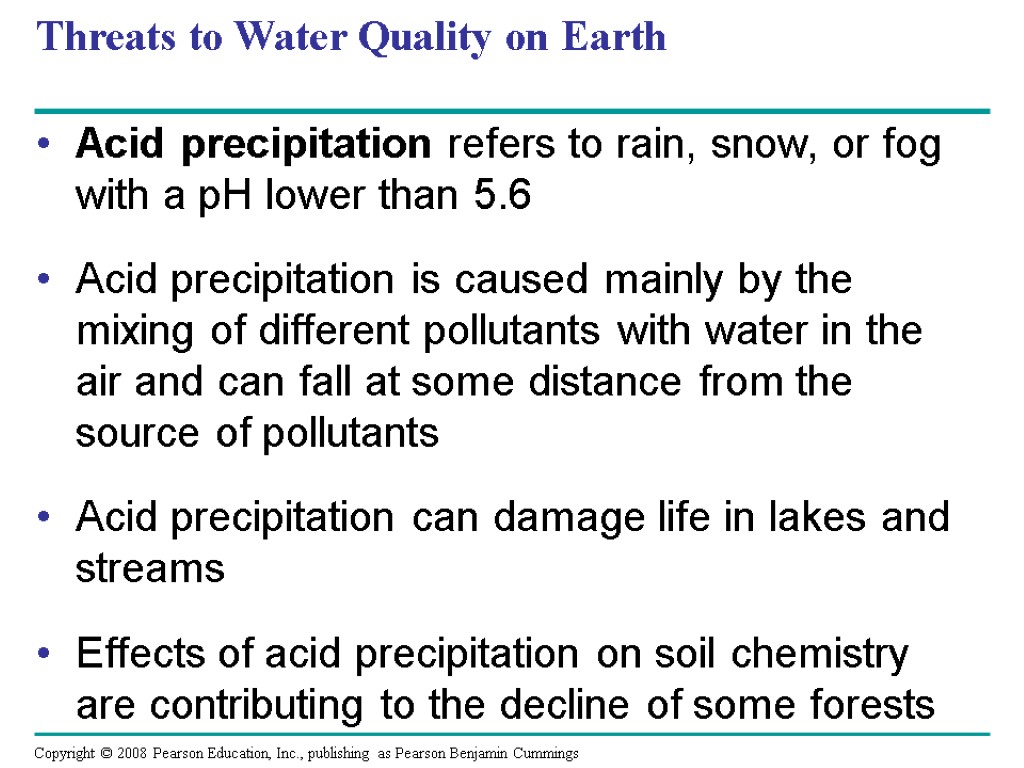


![Fig. 3-11 EXPERIMENT RESULTS Calcification rate (mmol CaCO3 per m2 per day) [CO32–] (µmol/kg) Fig. 3-11 EXPERIMENT RESULTS Calcification rate (mmol CaCO3 per m2 per day) [CO32–] (µmol/kg)](https://present5.com/customparser/226320678_438435023 --- 03_lecture_presentation_0080.ppt/slide_45.jpg)


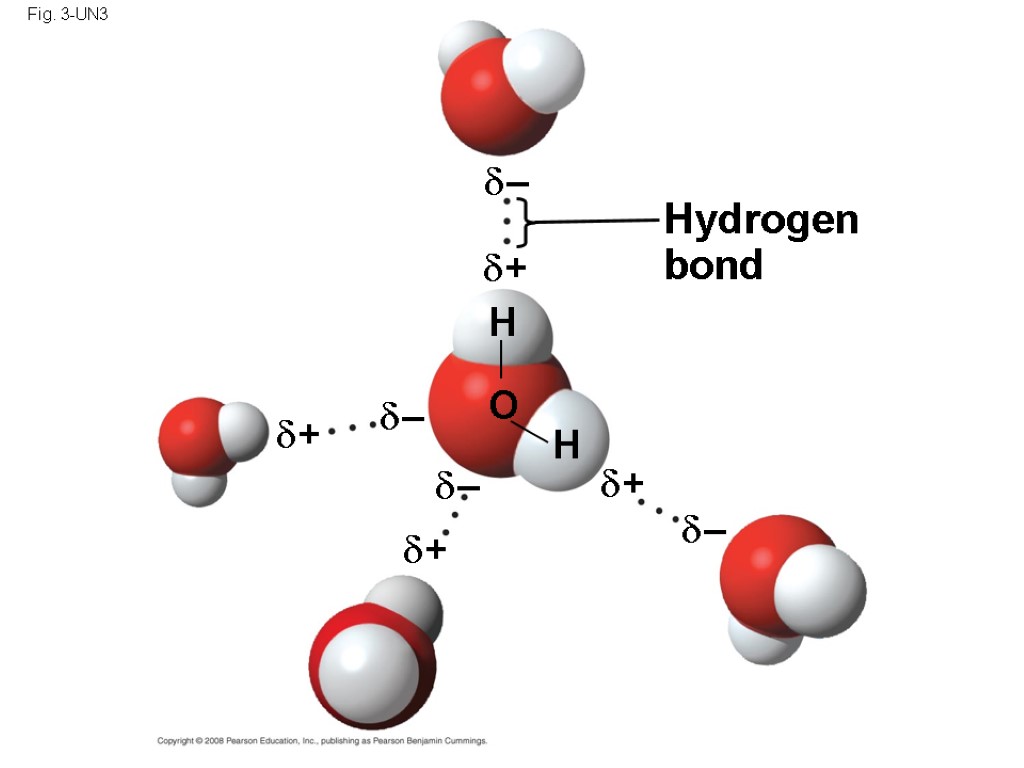

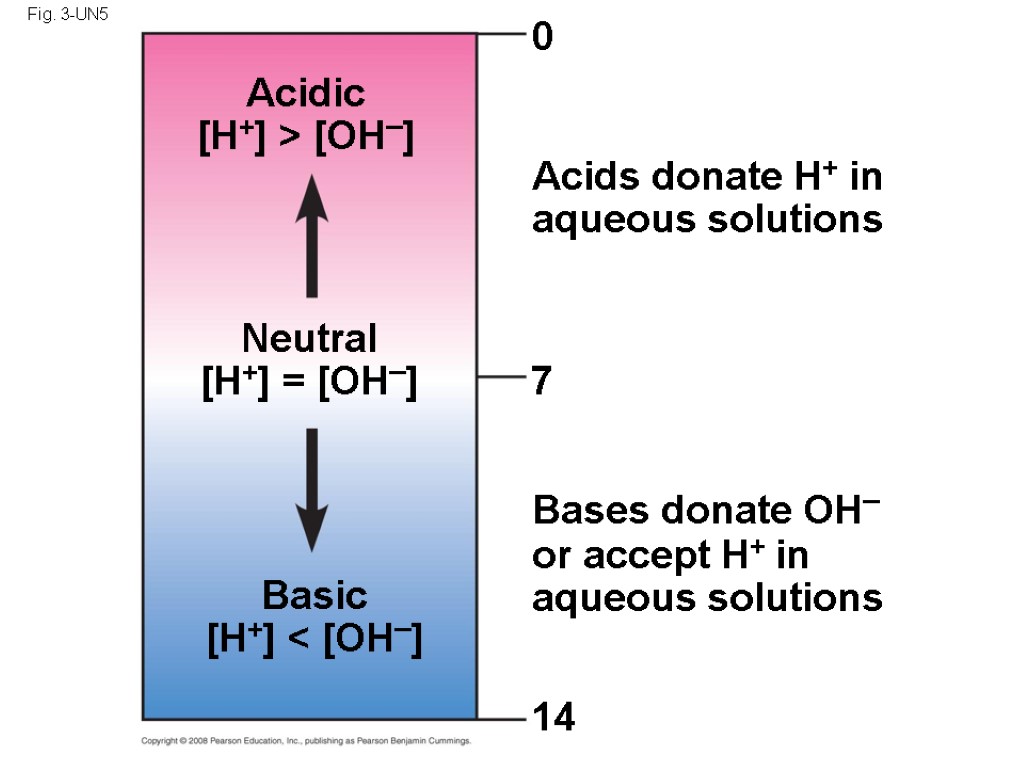
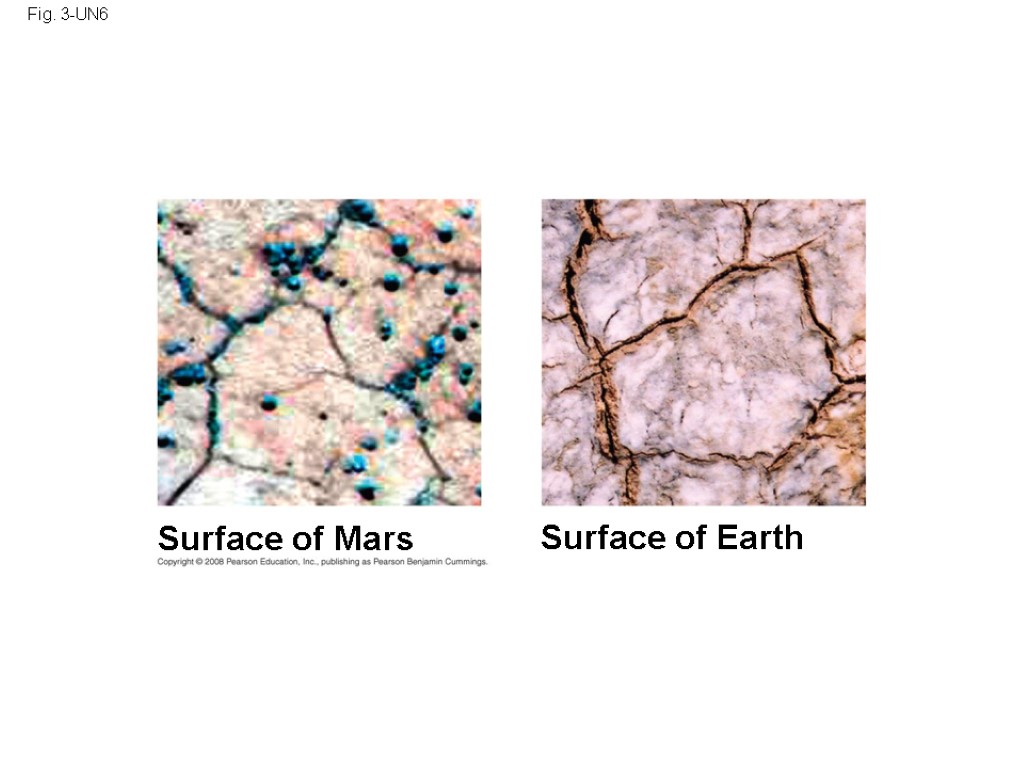

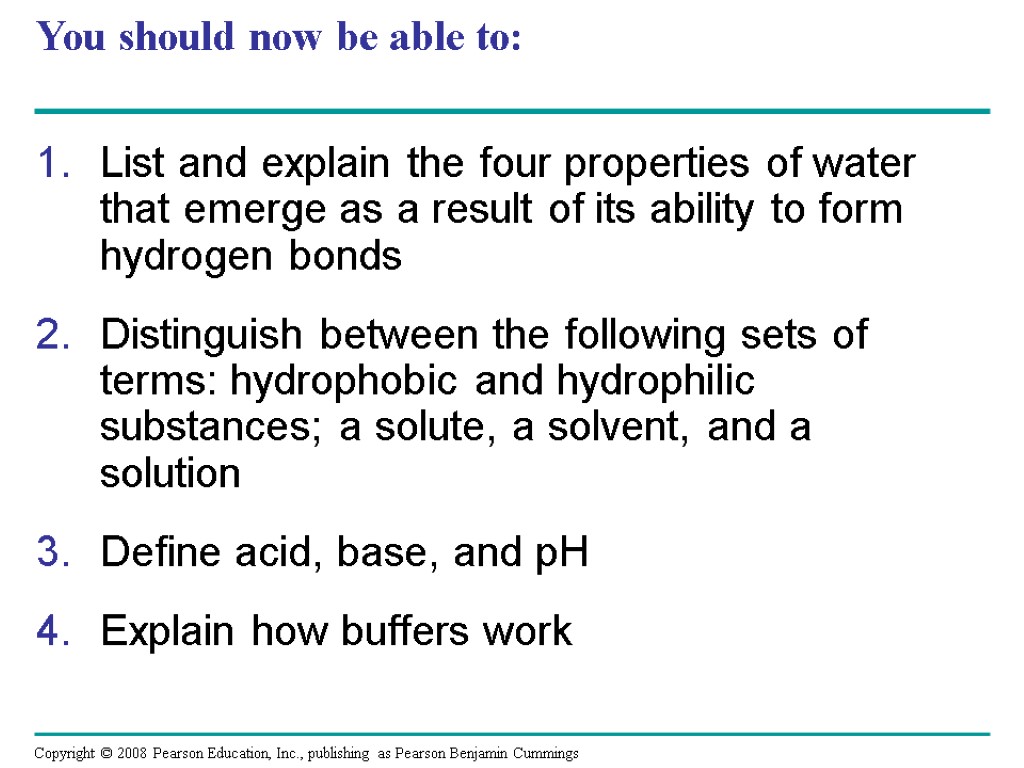
03_lecture_presentation_0080.ppt
- Количество слайдов: 53
 Chapter 3 Water and the Fitness of the Environment
Chapter 3 Water and the Fitness of the Environment
 Overview: The Molecule That Supports All of Life Water is the biological medium on Earth All living organisms require water more than any other substance Most cells are surrounded by water, and cells themselves are about 70–95% water The abundance of water is the main reason the Earth is habitable Copyright © 2008 Pearson Education, Inc., publishing as Pearson Benjamin Cummings
Overview: The Molecule That Supports All of Life Water is the biological medium on Earth All living organisms require water more than any other substance Most cells are surrounded by water, and cells themselves are about 70–95% water The abundance of water is the main reason the Earth is habitable Copyright © 2008 Pearson Education, Inc., publishing as Pearson Benjamin Cummings
 Fig. 3-1
Fig. 3-1
 Concept 3.1: The polarity of water molecules results in hydrogen bonding The water molecule is a polar molecule: The opposite ends have opposite charges Polarity allows water molecules to form hydrogen bonds with each other Animation: Water Structure Copyright © 2008 Pearson Education, Inc., publishing as Pearson Benjamin Cummings
Concept 3.1: The polarity of water molecules results in hydrogen bonding The water molecule is a polar molecule: The opposite ends have opposite charges Polarity allows water molecules to form hydrogen bonds with each other Animation: Water Structure Copyright © 2008 Pearson Education, Inc., publishing as Pearson Benjamin Cummings
 Fig. 3-2 Hydrogen bond – H + H O —— —— + + + – – –
Fig. 3-2 Hydrogen bond – H + H O —— —— + + + – – –
 Fig. 3-UN1
Fig. 3-UN1
 Concept 3.2: Four emergent properties of water contribute to Earth’s fitness for life Four of water’s properties that facilitate an environment for life are: Cohesive behavior Ability to moderate temperature Expansion upon freezing Versatility as a solvent Copyright © 2008 Pearson Education, Inc., publishing as Pearson Benjamin Cummings
Concept 3.2: Four emergent properties of water contribute to Earth’s fitness for life Four of water’s properties that facilitate an environment for life are: Cohesive behavior Ability to moderate temperature Expansion upon freezing Versatility as a solvent Copyright © 2008 Pearson Education, Inc., publishing as Pearson Benjamin Cummings
 Cohesion Collectively, hydrogen bonds hold water molecules together, a phenomenon called cohesion Cohesion helps the transport of water against gravity in plants Adhesion is an attraction between different substances, for example, between water and plant cell walls Animation: Water Transport Copyright © 2008 Pearson Education, Inc., publishing as Pearson Benjamin Cummings
Cohesion Collectively, hydrogen bonds hold water molecules together, a phenomenon called cohesion Cohesion helps the transport of water against gravity in plants Adhesion is an attraction between different substances, for example, between water and plant cell walls Animation: Water Transport Copyright © 2008 Pearson Education, Inc., publishing as Pearson Benjamin Cummings
 Fig. 3-3 Water-conducting cells Adhesion Cohesion 150 µm Direction of water movement
Fig. 3-3 Water-conducting cells Adhesion Cohesion 150 µm Direction of water movement
 Surface tension is a measure of how hard it is to break the surface of a liquid Surface tension is related to cohesion Copyright © 2008 Pearson Education, Inc., publishing as Pearson Benjamin Cummings
Surface tension is a measure of how hard it is to break the surface of a liquid Surface tension is related to cohesion Copyright © 2008 Pearson Education, Inc., publishing as Pearson Benjamin Cummings
 Fig. 3-4
Fig. 3-4
 Moderation of Temperature Water absorbs heat from warmer air and releases stored heat to cooler air Water can absorb or release a large amount of heat with only a slight change in its own temperature Copyright © 2008 Pearson Education, Inc., publishing as Pearson Benjamin Cummings
Moderation of Temperature Water absorbs heat from warmer air and releases stored heat to cooler air Water can absorb or release a large amount of heat with only a slight change in its own temperature Copyright © 2008 Pearson Education, Inc., publishing as Pearson Benjamin Cummings
 Heat and Temperature Kinetic energy is the energy of motion Heat is a measure of the total amount of kinetic energy due to molecular motion Temperature measures the intensity of heat due to the average kinetic energy of molecules Copyright © 2008 Pearson Education, Inc., publishing as Pearson Benjamin Cummings
Heat and Temperature Kinetic energy is the energy of motion Heat is a measure of the total amount of kinetic energy due to molecular motion Temperature measures the intensity of heat due to the average kinetic energy of molecules Copyright © 2008 Pearson Education, Inc., publishing as Pearson Benjamin Cummings
 The Celsius scale is a measure of temperature using Celsius degrees (°C) A calorie (cal) is the amount of heat required to raise the temperature of 1 g of water by 1°C The “calories” on food packages are actually kilocalories (kcal), where 1 kcal = 1,000 cal The joule (J) is another unit of energy where 1 J = 0.239 cal, or 1 cal = 4.184 J Copyright © 2008 Pearson Education, Inc., publishing as Pearson Benjamin Cummings
The Celsius scale is a measure of temperature using Celsius degrees (°C) A calorie (cal) is the amount of heat required to raise the temperature of 1 g of water by 1°C The “calories” on food packages are actually kilocalories (kcal), where 1 kcal = 1,000 cal The joule (J) is another unit of energy where 1 J = 0.239 cal, or 1 cal = 4.184 J Copyright © 2008 Pearson Education, Inc., publishing as Pearson Benjamin Cummings
 Water’s High Specific Heat The specific heat of a substance is the amount of heat that must be absorbed or lost for 1 g of that substance to change its temperature by 1ºC The specific heat of water is 1 cal/g/ºC Water resists changing its temperature because of its high specific heat Copyright © 2008 Pearson Education, Inc., publishing as Pearson Benjamin Cummings
Water’s High Specific Heat The specific heat of a substance is the amount of heat that must be absorbed or lost for 1 g of that substance to change its temperature by 1ºC The specific heat of water is 1 cal/g/ºC Water resists changing its temperature because of its high specific heat Copyright © 2008 Pearson Education, Inc., publishing as Pearson Benjamin Cummings
 Water’s high specific heat can be traced to hydrogen bonding Heat is absorbed when hydrogen bonds break Heat is released when hydrogen bonds form The high specific heat of water minimizes temperature fluctuations to within limits that permit life Copyright © 2008 Pearson Education, Inc., publishing as Pearson Benjamin Cummings
Water’s high specific heat can be traced to hydrogen bonding Heat is absorbed when hydrogen bonds break Heat is released when hydrogen bonds form The high specific heat of water minimizes temperature fluctuations to within limits that permit life Copyright © 2008 Pearson Education, Inc., publishing as Pearson Benjamin Cummings
 Fig. 3-5 San Diego 72° 40 miles Pacific Ocean 70s (°F) 80s 90s 100s Santa Barbara 73° Los Angeles (Airport) 75° Burbank 90° San Bernardino 100° Riverside 96° Santa Ana 84° Palm Springs 106°
Fig. 3-5 San Diego 72° 40 miles Pacific Ocean 70s (°F) 80s 90s 100s Santa Barbara 73° Los Angeles (Airport) 75° Burbank 90° San Bernardino 100° Riverside 96° Santa Ana 84° Palm Springs 106°
 Evaporative Cooling Evaporation is transformation of a substance from liquid to gas Heat of vaporization is the heat a liquid must absorb for 1 g to be converted to gas As a liquid evaporates, its remaining surface cools, a process called evaporative cooling Evaporative cooling of water helps stabilize temperatures in organisms and bodies of water Copyright © 2008 Pearson Education, Inc., publishing as Pearson Benjamin Cummings
Evaporative Cooling Evaporation is transformation of a substance from liquid to gas Heat of vaporization is the heat a liquid must absorb for 1 g to be converted to gas As a liquid evaporates, its remaining surface cools, a process called evaporative cooling Evaporative cooling of water helps stabilize temperatures in organisms and bodies of water Copyright © 2008 Pearson Education, Inc., publishing as Pearson Benjamin Cummings
 Insulation of Bodies of Water by Floating Ice Ice floats in liquid water because hydrogen bonds in ice are more “ordered,” making ice less dense Water reaches its greatest density at 4°C If ice sank, all bodies of water would eventually freeze solid, making life impossible on Earth Copyright © 2008 Pearson Education, Inc., publishing as Pearson Benjamin Cummings
Insulation of Bodies of Water by Floating Ice Ice floats in liquid water because hydrogen bonds in ice are more “ordered,” making ice less dense Water reaches its greatest density at 4°C If ice sank, all bodies of water would eventually freeze solid, making life impossible on Earth Copyright © 2008 Pearson Education, Inc., publishing as Pearson Benjamin Cummings
 Fig. 3-6 Hydrogen bond Liquid water Hydrogen bonds break and re-form Ice Hydrogen bonds are stable
Fig. 3-6 Hydrogen bond Liquid water Hydrogen bonds break and re-form Ice Hydrogen bonds are stable
 Fig. 3-6a Hydrogen bond Liquid water Hydrogen bonds break and re-form Ice Hydrogen bonds are stable
Fig. 3-6a Hydrogen bond Liquid water Hydrogen bonds break and re-form Ice Hydrogen bonds are stable
 The Solvent of Life A solution is a liquid that is a homogeneous mixture of substances A solvent is the dissolving agent of a solution The solute is the substance that is dissolved An aqueous solution is one in which water is the solvent Copyright © 2008 Pearson Education, Inc., publishing as Pearson Benjamin Cummings
The Solvent of Life A solution is a liquid that is a homogeneous mixture of substances A solvent is the dissolving agent of a solution The solute is the substance that is dissolved An aqueous solution is one in which water is the solvent Copyright © 2008 Pearson Education, Inc., publishing as Pearson Benjamin Cummings
 Water is a versatile solvent due to its polarity, which allows it to form hydrogen bonds easily When an ionic compound is dissolved in water, each ion is surrounded by a sphere of water molecules called a hydration shell Copyright © 2008 Pearson Education, Inc., publishing as Pearson Benjamin Cummings
Water is a versatile solvent due to its polarity, which allows it to form hydrogen bonds easily When an ionic compound is dissolved in water, each ion is surrounded by a sphere of water molecules called a hydration shell Copyright © 2008 Pearson Education, Inc., publishing as Pearson Benjamin Cummings
 Fig. 3-7 Cl– Na Cl– + + + + + + + + – – – – – – – – Na + – – – +
Fig. 3-7 Cl– Na Cl– + + + + + + + + – – – – – – – – Na + – – – +
 Water can also dissolve compounds made of nonionic polar molecules Even large polar molecules such as proteins can dissolve in water if they have ionic and polar regions Copyright © 2008 Pearson Education, Inc., publishing as Pearson Benjamin Cummings
Water can also dissolve compounds made of nonionic polar molecules Even large polar molecules such as proteins can dissolve in water if they have ionic and polar regions Copyright © 2008 Pearson Education, Inc., publishing as Pearson Benjamin Cummings
 Fig. 3-8 (a) Lysozyme molecule in a nonaqueous environment (b) Lysozyme molecule (purple) in an aqueous environment (c) Ionic and polar regions on the protein’s surface attract water molecules.
Fig. 3-8 (a) Lysozyme molecule in a nonaqueous environment (b) Lysozyme molecule (purple) in an aqueous environment (c) Ionic and polar regions on the protein’s surface attract water molecules.
 Fig. 3-8ab (b) Lysozyme molecule (purple) in an aqueous environment (a) Lysozyme molecule in a nonaqueous environment
Fig. 3-8ab (b) Lysozyme molecule (purple) in an aqueous environment (a) Lysozyme molecule in a nonaqueous environment
 Fig. 3-8bc (c) Ionic and polar regions on the protein’s surface attract water molecules. (b) Lysozyme molecule (purple) in an aqueous environment
Fig. 3-8bc (c) Ionic and polar regions on the protein’s surface attract water molecules. (b) Lysozyme molecule (purple) in an aqueous environment
 Hydrophilic and Hydrophobic Substances A hydrophilic substance is one that has an affinity for water A hydrophobic substance is one that does not have an affinity for water Oil molecules are hydrophobic because they have relatively nonpolar bonds A colloid is a stable suspension of fine particles in a liquid Copyright © 2008 Pearson Education, Inc., publishing as Pearson Benjamin Cummings
Hydrophilic and Hydrophobic Substances A hydrophilic substance is one that has an affinity for water A hydrophobic substance is one that does not have an affinity for water Oil molecules are hydrophobic because they have relatively nonpolar bonds A colloid is a stable suspension of fine particles in a liquid Copyright © 2008 Pearson Education, Inc., publishing as Pearson Benjamin Cummings
 Solute Concentration in Aqueous Solutions Most biochemical reactions occur in water Chemical reactions depend on collisions of molecules and therefore on the concentration of solutes in an aqueous solution Copyright © 2008 Pearson Education, Inc., publishing as Pearson Benjamin Cummings
Solute Concentration in Aqueous Solutions Most biochemical reactions occur in water Chemical reactions depend on collisions of molecules and therefore on the concentration of solutes in an aqueous solution Copyright © 2008 Pearson Education, Inc., publishing as Pearson Benjamin Cummings
 Molecular mass is the sum of all masses of all atoms in a molecule Numbers of molecules are usually measured in moles, where 1 mole (mol) = 6.02 x 1023 molecules Avogadro’s number and the unit dalton were defined such that 6.02 x 1023 daltons = 1 g Molarity (M) is the number of moles of solute per liter of solution Copyright © 2008 Pearson Education, Inc., publishing as Pearson Benjamin Cummings
Molecular mass is the sum of all masses of all atoms in a molecule Numbers of molecules are usually measured in moles, where 1 mole (mol) = 6.02 x 1023 molecules Avogadro’s number and the unit dalton were defined such that 6.02 x 1023 daltons = 1 g Molarity (M) is the number of moles of solute per liter of solution Copyright © 2008 Pearson Education, Inc., publishing as Pearson Benjamin Cummings
 Concept 3.3: Acidic and basic conditions affect living organisms A hydrogen atom in a hydrogen bond between two water molecules can shift from one to the other: The hydrogen atom leaves its electron behind and is transferred as a proton, or hydrogen ion (H+) The molecule with the extra proton is now a hydronium ion (H3O+), though it is often represented as H+ The molecule that lost the proton is now a hydroxide ion (OH–) Copyright © 2008 Pearson Education, Inc., publishing as Pearson Benjamin Cummings
Concept 3.3: Acidic and basic conditions affect living organisms A hydrogen atom in a hydrogen bond between two water molecules can shift from one to the other: The hydrogen atom leaves its electron behind and is transferred as a proton, or hydrogen ion (H+) The molecule with the extra proton is now a hydronium ion (H3O+), though it is often represented as H+ The molecule that lost the proton is now a hydroxide ion (OH–) Copyright © 2008 Pearson Education, Inc., publishing as Pearson Benjamin Cummings
 Water is in a state of dynamic equilibrium in which water molecules dissociate at the same rate at which they are being reformed Copyright © 2008 Pearson Education, Inc., publishing as Pearson Benjamin Cummings
Water is in a state of dynamic equilibrium in which water molecules dissociate at the same rate at which they are being reformed Copyright © 2008 Pearson Education, Inc., publishing as Pearson Benjamin Cummings
 Fig. 3-UN2 Hydronium ion (H3O+) Hydroxide ion (OH–) 2H2O H H H H H H H H O O O O
Fig. 3-UN2 Hydronium ion (H3O+) Hydroxide ion (OH–) 2H2O H H H H H H H H O O O O
 Though statistically rare, the dissociation of water molecules has a great effect on organisms Changes in concentrations of H+ and OH– can drastically affect the chemistry of a cell Copyright © 2008 Pearson Education, Inc., publishing as Pearson Benjamin Cummings
Though statistically rare, the dissociation of water molecules has a great effect on organisms Changes in concentrations of H+ and OH– can drastically affect the chemistry of a cell Copyright © 2008 Pearson Education, Inc., publishing as Pearson Benjamin Cummings
 Effects of Changes in pH Concentrations of H+ and OH– are equal in pure water Adding certain solutes, called acids and bases, modifies the concentrations of H+ and OH– Biologists use something called the pH scale to describe whether a solution is acidic or basic (the opposite of acidic) Copyright © 2008 Pearson Education, Inc., publishing as Pearson Benjamin Cummings
Effects of Changes in pH Concentrations of H+ and OH– are equal in pure water Adding certain solutes, called acids and bases, modifies the concentrations of H+ and OH– Biologists use something called the pH scale to describe whether a solution is acidic or basic (the opposite of acidic) Copyright © 2008 Pearson Education, Inc., publishing as Pearson Benjamin Cummings
 Acids and Bases An acid is any substance that increases the H+ concentration of a solution A base is any substance that reduces the H+ concentration of a solution Copyright © 2008 Pearson Education, Inc., publishing as Pearson Benjamin Cummings
Acids and Bases An acid is any substance that increases the H+ concentration of a solution A base is any substance that reduces the H+ concentration of a solution Copyright © 2008 Pearson Education, Inc., publishing as Pearson Benjamin Cummings
 The pH Scale In any aqueous solution at 25°C the product of H+ and OH– is constant and can be written as [H+][OH–] = 10–14 The pH of a solution is defined by the negative logarithm of H+ concentration, written as pH = –log [H+] For a neutral aqueous solution [H+] is 10–7 = –(–7) = 7 Copyright © 2008 Pearson Education, Inc., publishing as Pearson Benjamin Cummings
The pH Scale In any aqueous solution at 25°C the product of H+ and OH– is constant and can be written as [H+][OH–] = 10–14 The pH of a solution is defined by the negative logarithm of H+ concentration, written as pH = –log [H+] For a neutral aqueous solution [H+] is 10–7 = –(–7) = 7 Copyright © 2008 Pearson Education, Inc., publishing as Pearson Benjamin Cummings
 Acidic solutions have pH values less than 7 Basic solutions have pH values greater than 7 Most biological fluids have pH values in the range of 6 to 8 Copyright © 2008 Pearson Education, Inc., publishing as Pearson Benjamin Cummings
Acidic solutions have pH values less than 7 Basic solutions have pH values greater than 7 Most biological fluids have pH values in the range of 6 to 8 Copyright © 2008 Pearson Education, Inc., publishing as Pearson Benjamin Cummings
 Fig. 3-9 Neutral solution Acidic solution Basic solution OH– OH– OH– OH– OH– OH– OH– H+ H+ H+ OH– H+ H+ H+ H+ OH– OH– OH– OH– H+ OH– H+ H+ H+ H+ H+ H+ H+ OH– Neutral [H+] = [OH–] Increasingly Acidic [H+] > [OH–] Increasingly Basic [H+] < [OH–] pH Scale 0 1 2 3 4 5 6 7 8 Battery acid Gastric juice, lemon juice Vinegar, beer, wine, cola Tomato juice Black coffee Rainwater Urine Saliva Pure water Human blood, tears Seawater 9 10 Milk of magnesia Household ammonia Household bleach Oven cleaner 11 12 13 14
Fig. 3-9 Neutral solution Acidic solution Basic solution OH– OH– OH– OH– OH– OH– OH– H+ H+ H+ OH– H+ H+ H+ H+ OH– OH– OH– OH– H+ OH– H+ H+ H+ H+ H+ H+ H+ OH– Neutral [H+] = [OH–] Increasingly Acidic [H+] > [OH–] Increasingly Basic [H+] < [OH–] pH Scale 0 1 2 3 4 5 6 7 8 Battery acid Gastric juice, lemon juice Vinegar, beer, wine, cola Tomato juice Black coffee Rainwater Urine Saliva Pure water Human blood, tears Seawater 9 10 Milk of magnesia Household ammonia Household bleach Oven cleaner 11 12 13 14
 Buffers The internal pH of most living cells must remain close to pH 7 Buffers are substances that minimize changes in concentrations of H+ and OH– in a solution Most buffers consist of an acid-base pair that reversibly combines with H+ Copyright © 2008 Pearson Education, Inc., publishing as Pearson Benjamin Cummings
Buffers The internal pH of most living cells must remain close to pH 7 Buffers are substances that minimize changes in concentrations of H+ and OH– in a solution Most buffers consist of an acid-base pair that reversibly combines with H+ Copyright © 2008 Pearson Education, Inc., publishing as Pearson Benjamin Cummings
 Threats to Water Quality on Earth Acid precipitation refers to rain, snow, or fog with a pH lower than 5.6 Acid precipitation is caused mainly by the mixing of different pollutants with water in the air and can fall at some distance from the source of pollutants Acid precipitation can damage life in lakes and streams Effects of acid precipitation on soil chemistry are contributing to the decline of some forests Copyright © 2008 Pearson Education, Inc., publishing as Pearson Benjamin Cummings
Threats to Water Quality on Earth Acid precipitation refers to rain, snow, or fog with a pH lower than 5.6 Acid precipitation is caused mainly by the mixing of different pollutants with water in the air and can fall at some distance from the source of pollutants Acid precipitation can damage life in lakes and streams Effects of acid precipitation on soil chemistry are contributing to the decline of some forests Copyright © 2008 Pearson Education, Inc., publishing as Pearson Benjamin Cummings
 Fig. 3-10 More acidic 0 Acid rain Acid rain Normal rain More basic 1 2 3 4 5 6 7 8 9 10 11 12 13 14
Fig. 3-10 More acidic 0 Acid rain Acid rain Normal rain More basic 1 2 3 4 5 6 7 8 9 10 11 12 13 14
 Human activities such as burning fossil fuels threaten water quality CO2 is released by fossil fuel combustion and contributes to: A warming of earth called the “greenhouse” effect Acidification of the oceans; this leads to a decrease in the ability of corals to form calcified reefs Copyright © 2008 Pearson Education, Inc., publishing as Pearson Benjamin Cummings
Human activities such as burning fossil fuels threaten water quality CO2 is released by fossil fuel combustion and contributes to: A warming of earth called the “greenhouse” effect Acidification of the oceans; this leads to a decrease in the ability of corals to form calcified reefs Copyright © 2008 Pearson Education, Inc., publishing as Pearson Benjamin Cummings
![>Fig. 3-11 EXPERIMENT RESULTS Calcification rate (mmol CaCO3 per m2 per day) [CO32–] (µmol/kg) >Fig. 3-11 EXPERIMENT RESULTS Calcification rate (mmol CaCO3 per m2 per day) [CO32–] (µmol/kg)](https://present5.com/customparser/226320678_438435023 --- 03_lecture_presentation_0080.ppt/slide_45.jpg) Fig. 3-11 EXPERIMENT RESULTS Calcification rate (mmol CaCO3 per m2 per day) [CO32–] (µmol/kg) 150 200 250 300 0 20 40
Fig. 3-11 EXPERIMENT RESULTS Calcification rate (mmol CaCO3 per m2 per day) [CO32–] (µmol/kg) 150 200 250 300 0 20 40
 Fig. 3-11a EXPERIMENT
Fig. 3-11a EXPERIMENT
 Fig. 3-11b Calcification rate (mmol CaCO3 per m2 per day) 40 20 0 300 150 200 250 [CO32–] (µmol/kg) RESULTS
Fig. 3-11b Calcification rate (mmol CaCO3 per m2 per day) 40 20 0 300 150 200 250 [CO32–] (µmol/kg) RESULTS
 Fig. 3-UN3 Hydrogen bond – + + + + – – – H H O
Fig. 3-UN3 Hydrogen bond – + + + + – – – H H O
 Fig. 3-UN4 Liquid water: transient hydrogen bonds Ice: stable hydro- gen bonds
Fig. 3-UN4 Liquid water: transient hydrogen bonds Ice: stable hydro- gen bonds
 Fig. 3-UN5 Bases donate OH– or accept H+ in aqueous solutions Acids donate H+ in aqueous solutions Acidic [H+] > [OH–] Neutral [H+] = [OH–] Basic [H+] < [OH–] 14 7 0
Fig. 3-UN5 Bases donate OH– or accept H+ in aqueous solutions Acids donate H+ in aqueous solutions Acidic [H+] > [OH–] Neutral [H+] = [OH–] Basic [H+] < [OH–] 14 7 0
 Fig. 3-UN6 Surface of Earth Surface of Mars
Fig. 3-UN6 Surface of Earth Surface of Mars
 Fig. 3-UN7
Fig. 3-UN7
 You should now be able to: List and explain the four properties of water that emerge as a result of its ability to form hydrogen bonds Distinguish between the following sets of terms: hydrophobic and hydrophilic substances; a solute, a solvent, and a solution Define acid, base, and pH Explain how buffers work Copyright © 2008 Pearson Education, Inc., publishing as Pearson Benjamin Cummings
You should now be able to: List and explain the four properties of water that emerge as a result of its ability to form hydrogen bonds Distinguish between the following sets of terms: hydrophobic and hydrophilic substances; a solute, a solvent, and a solution Define acid, base, and pH Explain how buffers work Copyright © 2008 Pearson Education, Inc., publishing as Pearson Benjamin Cummings

